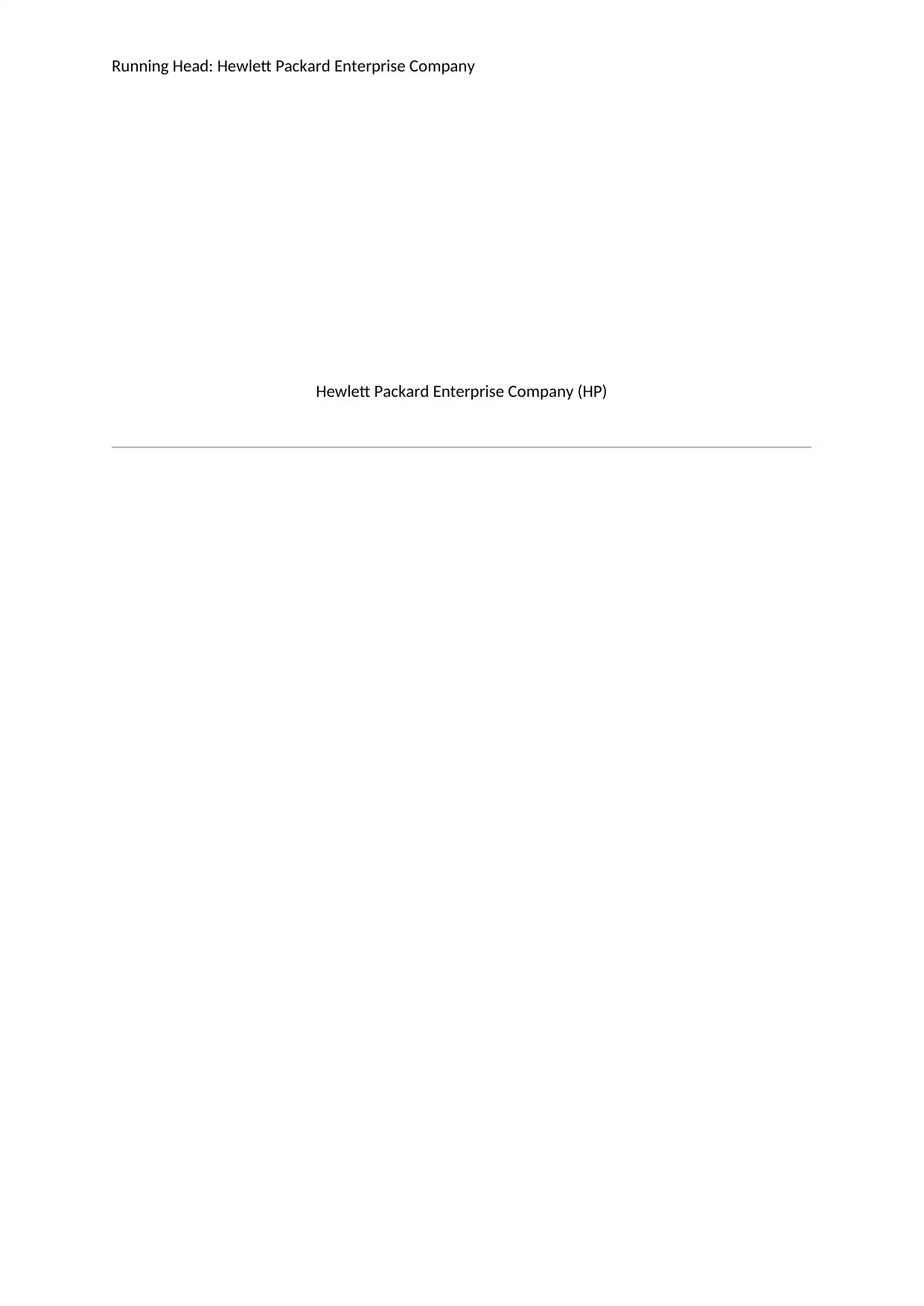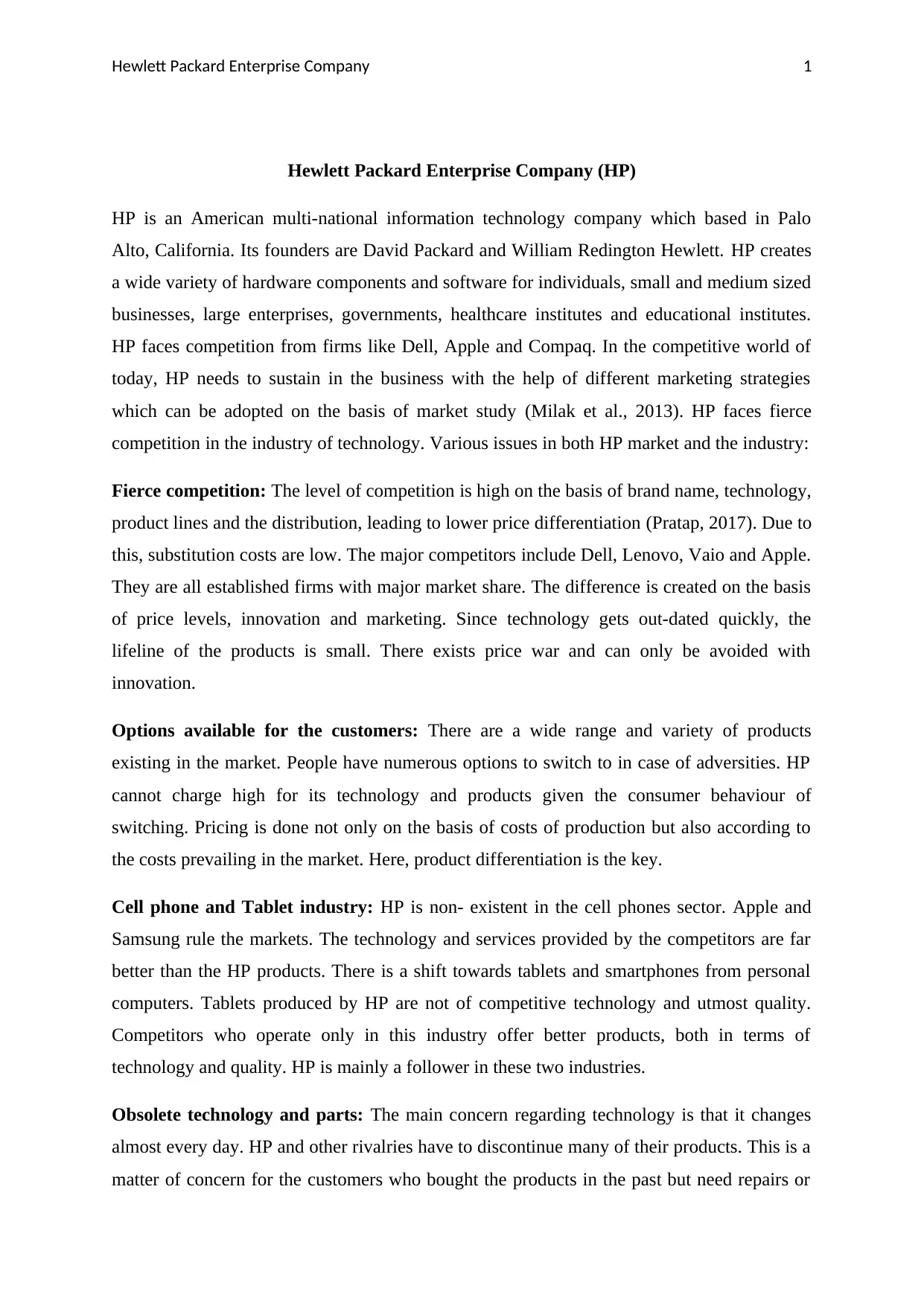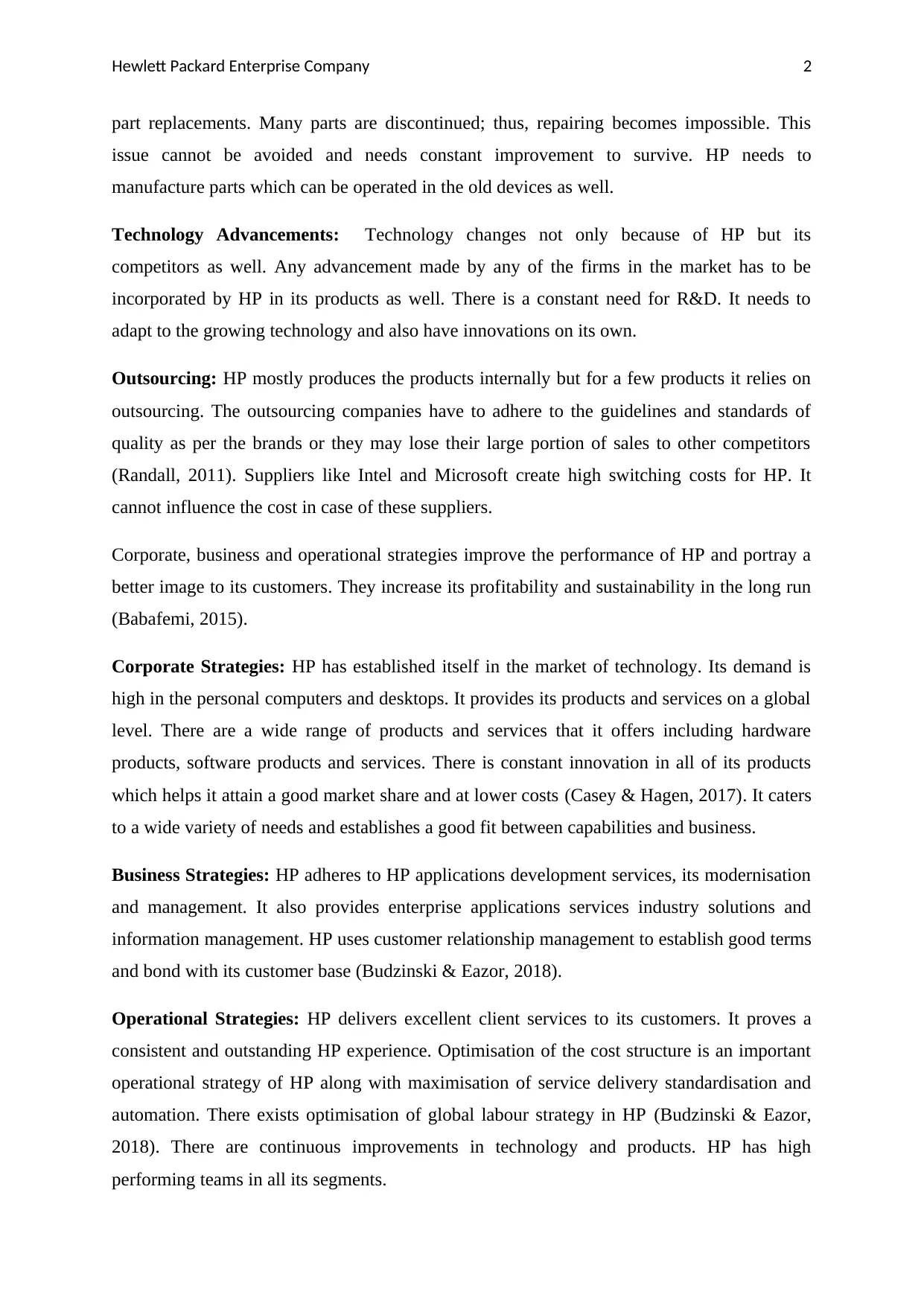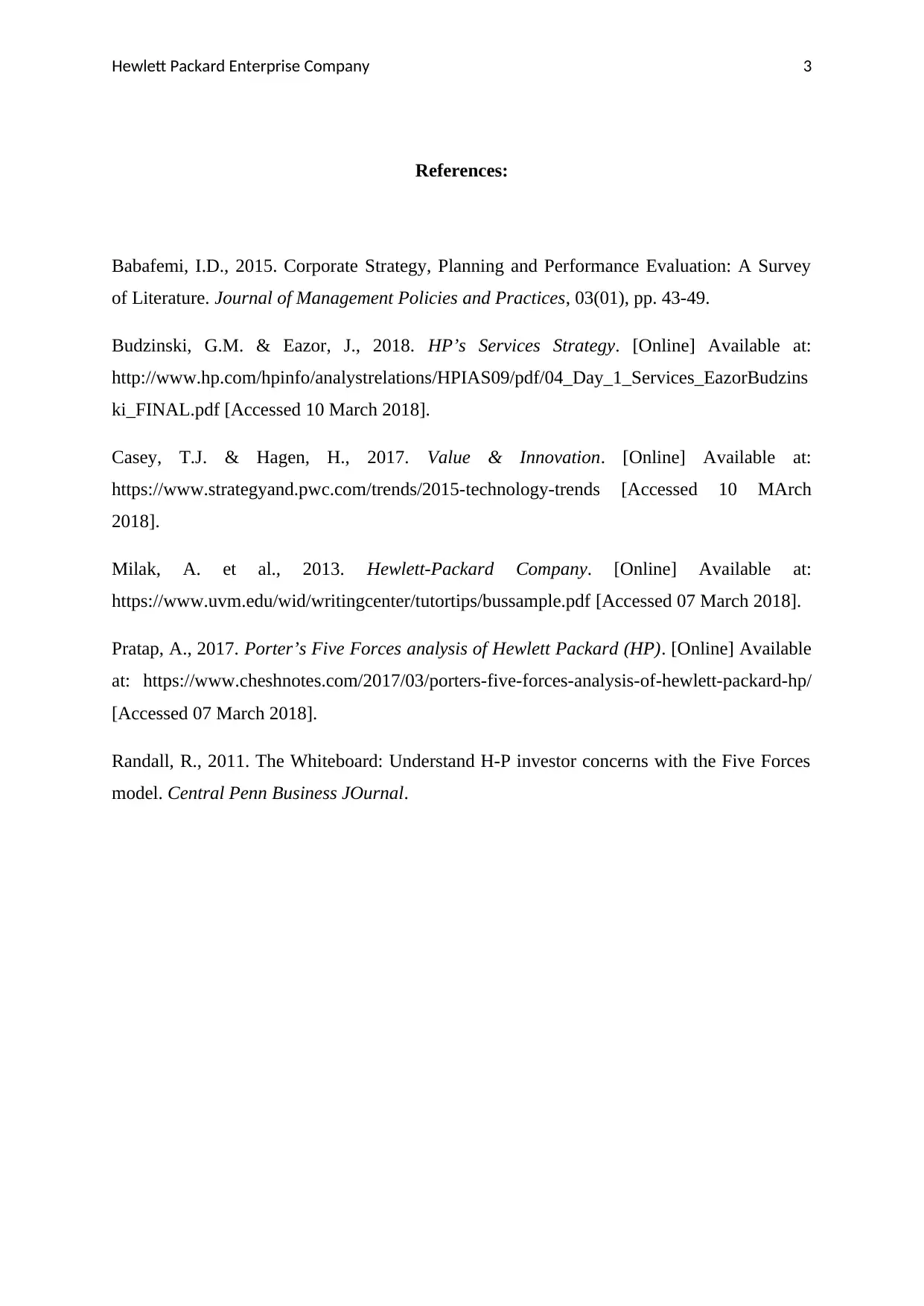Strategic Analysis: Hewlett Packard Enterprise's Market Position
VerifiedAdded on 2023/06/15
|4
|1134
|154
Report
AI Summary
This report provides an analysis of Hewlett Packard Enterprise Company (HP), focusing on its market position, competitive challenges, and strategic options. It identifies fierce competition from companies like Dell and Apple as a major issue, leading to lower price differentiation and the need for constant innovation. The report also discusses HP's lack of presence in the cell phone sector, the rapid obsolescence of technology, and the importance of adapting to technological advancements through research and development. Furthermore, it highlights HP's corporate, business, and operational strategies, including application development services, customer relationship management, and cost structure optimization. The analysis emphasizes the need for continuous improvement and adaptation to maintain a competitive edge in the technology industry.

Running Head: Hewlett Packard Enterprise Company
Hewlett Packard Enterprise Company (HP)
Hewlett Packard Enterprise Company (HP)
Paraphrase This Document
Need a fresh take? Get an instant paraphrase of this document with our AI Paraphraser

Hewlett Packard Enterprise Company 1
Hewlett Packard Enterprise Company (HP)
HP is an American multi-national information technology company which based in Palo
Alto, California. Its founders are David Packard and William Redington Hewlett. HP creates
a wide variety of hardware components and software for individuals, small and medium sized
businesses, large enterprises, governments, healthcare institutes and educational institutes.
HP faces competition from firms like Dell, Apple and Compaq. In the competitive world of
today, HP needs to sustain in the business with the help of different marketing strategies
which can be adopted on the basis of market study (Milak et al., 2013). HP faces fierce
competition in the industry of technology. Various issues in both HP market and the industry:
Fierce competition: The level of competition is high on the basis of brand name, technology,
product lines and the distribution, leading to lower price differentiation (Pratap, 2017). Due to
this, substitution costs are low. The major competitors include Dell, Lenovo, Vaio and Apple.
They are all established firms with major market share. The difference is created on the basis
of price levels, innovation and marketing. Since technology gets out-dated quickly, the
lifeline of the products is small. There exists price war and can only be avoided with
innovation.
Options available for the customers: There are a wide range and variety of products
existing in the market. People have numerous options to switch to in case of adversities. HP
cannot charge high for its technology and products given the consumer behaviour of
switching. Pricing is done not only on the basis of costs of production but also according to
the costs prevailing in the market. Here, product differentiation is the key.
Cell phone and Tablet industry: HP is non- existent in the cell phones sector. Apple and
Samsung rule the markets. The technology and services provided by the competitors are far
better than the HP products. There is a shift towards tablets and smartphones from personal
computers. Tablets produced by HP are not of competitive technology and utmost quality.
Competitors who operate only in this industry offer better products, both in terms of
technology and quality. HP is mainly a follower in these two industries.
Obsolete technology and parts: The main concern regarding technology is that it changes
almost every day. HP and other rivalries have to discontinue many of their products. This is a
matter of concern for the customers who bought the products in the past but need repairs or
Hewlett Packard Enterprise Company (HP)
HP is an American multi-national information technology company which based in Palo
Alto, California. Its founders are David Packard and William Redington Hewlett. HP creates
a wide variety of hardware components and software for individuals, small and medium sized
businesses, large enterprises, governments, healthcare institutes and educational institutes.
HP faces competition from firms like Dell, Apple and Compaq. In the competitive world of
today, HP needs to sustain in the business with the help of different marketing strategies
which can be adopted on the basis of market study (Milak et al., 2013). HP faces fierce
competition in the industry of technology. Various issues in both HP market and the industry:
Fierce competition: The level of competition is high on the basis of brand name, technology,
product lines and the distribution, leading to lower price differentiation (Pratap, 2017). Due to
this, substitution costs are low. The major competitors include Dell, Lenovo, Vaio and Apple.
They are all established firms with major market share. The difference is created on the basis
of price levels, innovation and marketing. Since technology gets out-dated quickly, the
lifeline of the products is small. There exists price war and can only be avoided with
innovation.
Options available for the customers: There are a wide range and variety of products
existing in the market. People have numerous options to switch to in case of adversities. HP
cannot charge high for its technology and products given the consumer behaviour of
switching. Pricing is done not only on the basis of costs of production but also according to
the costs prevailing in the market. Here, product differentiation is the key.
Cell phone and Tablet industry: HP is non- existent in the cell phones sector. Apple and
Samsung rule the markets. The technology and services provided by the competitors are far
better than the HP products. There is a shift towards tablets and smartphones from personal
computers. Tablets produced by HP are not of competitive technology and utmost quality.
Competitors who operate only in this industry offer better products, both in terms of
technology and quality. HP is mainly a follower in these two industries.
Obsolete technology and parts: The main concern regarding technology is that it changes
almost every day. HP and other rivalries have to discontinue many of their products. This is a
matter of concern for the customers who bought the products in the past but need repairs or

Hewlett Packard Enterprise Company 2
part replacements. Many parts are discontinued; thus, repairing becomes impossible. This
issue cannot be avoided and needs constant improvement to survive. HP needs to
manufacture parts which can be operated in the old devices as well.
Technology Advancements: Technology changes not only because of HP but its
competitors as well. Any advancement made by any of the firms in the market has to be
incorporated by HP in its products as well. There is a constant need for R&D. It needs to
adapt to the growing technology and also have innovations on its own.
Outsourcing: HP mostly produces the products internally but for a few products it relies on
outsourcing. The outsourcing companies have to adhere to the guidelines and standards of
quality as per the brands or they may lose their large portion of sales to other competitors
(Randall, 2011). Suppliers like Intel and Microsoft create high switching costs for HP. It
cannot influence the cost in case of these suppliers.
Corporate, business and operational strategies improve the performance of HP and portray a
better image to its customers. They increase its profitability and sustainability in the long run
(Babafemi, 2015).
Corporate Strategies: HP has established itself in the market of technology. Its demand is
high in the personal computers and desktops. It provides its products and services on a global
level. There are a wide range of products and services that it offers including hardware
products, software products and services. There is constant innovation in all of its products
which helps it attain a good market share and at lower costs (Casey & Hagen, 2017). It caters
to a wide variety of needs and establishes a good fit between capabilities and business.
Business Strategies: HP adheres to HP applications development services, its modernisation
and management. It also provides enterprise applications services industry solutions and
information management. HP uses customer relationship management to establish good terms
and bond with its customer base (Budzinski & Eazor, 2018).
Operational Strategies: HP delivers excellent client services to its customers. It proves a
consistent and outstanding HP experience. Optimisation of the cost structure is an important
operational strategy of HP along with maximisation of service delivery standardisation and
automation. There exists optimisation of global labour strategy in HP (Budzinski & Eazor,
2018). There are continuous improvements in technology and products. HP has high
performing teams in all its segments.
part replacements. Many parts are discontinued; thus, repairing becomes impossible. This
issue cannot be avoided and needs constant improvement to survive. HP needs to
manufacture parts which can be operated in the old devices as well.
Technology Advancements: Technology changes not only because of HP but its
competitors as well. Any advancement made by any of the firms in the market has to be
incorporated by HP in its products as well. There is a constant need for R&D. It needs to
adapt to the growing technology and also have innovations on its own.
Outsourcing: HP mostly produces the products internally but for a few products it relies on
outsourcing. The outsourcing companies have to adhere to the guidelines and standards of
quality as per the brands or they may lose their large portion of sales to other competitors
(Randall, 2011). Suppliers like Intel and Microsoft create high switching costs for HP. It
cannot influence the cost in case of these suppliers.
Corporate, business and operational strategies improve the performance of HP and portray a
better image to its customers. They increase its profitability and sustainability in the long run
(Babafemi, 2015).
Corporate Strategies: HP has established itself in the market of technology. Its demand is
high in the personal computers and desktops. It provides its products and services on a global
level. There are a wide range of products and services that it offers including hardware
products, software products and services. There is constant innovation in all of its products
which helps it attain a good market share and at lower costs (Casey & Hagen, 2017). It caters
to a wide variety of needs and establishes a good fit between capabilities and business.
Business Strategies: HP adheres to HP applications development services, its modernisation
and management. It also provides enterprise applications services industry solutions and
information management. HP uses customer relationship management to establish good terms
and bond with its customer base (Budzinski & Eazor, 2018).
Operational Strategies: HP delivers excellent client services to its customers. It proves a
consistent and outstanding HP experience. Optimisation of the cost structure is an important
operational strategy of HP along with maximisation of service delivery standardisation and
automation. There exists optimisation of global labour strategy in HP (Budzinski & Eazor,
2018). There are continuous improvements in technology and products. HP has high
performing teams in all its segments.
⊘ This is a preview!⊘
Do you want full access?
Subscribe today to unlock all pages.

Trusted by 1+ million students worldwide

Hewlett Packard Enterprise Company 3
References:
Babafemi, I.D., 2015. Corporate Strategy, Planning and Performance Evaluation: A Survey
of Literature. Journal of Management Policies and Practices, 03(01), pp. 43-49.
Budzinski, G.M. & Eazor, J., 2018. HP’s Services Strategy. [Online] Available at:
http://www.hp.com/hpinfo/analystrelations/HPIAS09/pdf/04_Day_1_Services_EazorBudzins
ki_FINAL.pdf [Accessed 10 March 2018].
Casey, T.J. & Hagen, H., 2017. Value & Innovation. [Online] Available at:
https://www.strategyand.pwc.com/trends/2015-technology-trends [Accessed 10 MArch
2018].
Milak, A. et al., 2013. Hewlett-Packard Company. [Online] Available at:
https://www.uvm.edu/wid/writingcenter/tutortips/bussample.pdf [Accessed 07 March 2018].
Pratap, A., 2017. Porter’s Five Forces analysis of Hewlett Packard (HP). [Online] Available
at: https://www.cheshnotes.com/2017/03/porters-five-forces-analysis-of-hewlett-packard-hp/
[Accessed 07 March 2018].
Randall, R., 2011. The Whiteboard: Understand H-P investor concerns with the Five Forces
model. Central Penn Business JOurnal.
References:
Babafemi, I.D., 2015. Corporate Strategy, Planning and Performance Evaluation: A Survey
of Literature. Journal of Management Policies and Practices, 03(01), pp. 43-49.
Budzinski, G.M. & Eazor, J., 2018. HP’s Services Strategy. [Online] Available at:
http://www.hp.com/hpinfo/analystrelations/HPIAS09/pdf/04_Day_1_Services_EazorBudzins
ki_FINAL.pdf [Accessed 10 March 2018].
Casey, T.J. & Hagen, H., 2017. Value & Innovation. [Online] Available at:
https://www.strategyand.pwc.com/trends/2015-technology-trends [Accessed 10 MArch
2018].
Milak, A. et al., 2013. Hewlett-Packard Company. [Online] Available at:
https://www.uvm.edu/wid/writingcenter/tutortips/bussample.pdf [Accessed 07 March 2018].
Pratap, A., 2017. Porter’s Five Forces analysis of Hewlett Packard (HP). [Online] Available
at: https://www.cheshnotes.com/2017/03/porters-five-forces-analysis-of-hewlett-packard-hp/
[Accessed 07 March 2018].
Randall, R., 2011. The Whiteboard: Understand H-P investor concerns with the Five Forces
model. Central Penn Business JOurnal.
1 out of 4
Related Documents
Your All-in-One AI-Powered Toolkit for Academic Success.
+13062052269
info@desklib.com
Available 24*7 on WhatsApp / Email
![[object Object]](/_next/static/media/star-bottom.7253800d.svg)
Unlock your academic potential
Copyright © 2020–2025 A2Z Services. All Rights Reserved. Developed and managed by ZUCOL.




